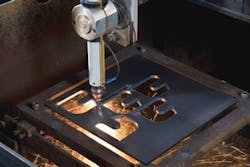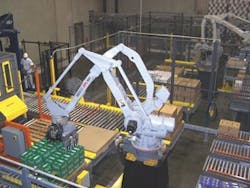But if you're a machine- or robot-builder OEM, distributed manufacturing at multiple sites is much more difficult to execute. Many machines and robots are highly complex and often made-to-order with custom programming and configuration—processes that can't be turned over easily to a plant distant from central engineering.
International Wheel & Tire manufactures tire balancers for the automotive OEM and tire industries at its single plant in Oak Park, Michigan. "Each system is validated and certified and then disassembled and shipped to the customer," explains Kevin Kerwin, IWT vice president and CEO. "In comparison to the overall cost of the balancers, disassembly, shipping and re-assembly are minor."
Peter Brahan, automation team leader at Hypertherm in Hanover, New Hampshire, says shipping is a problem for some of its customers, but not for them. Hypertherm builds plasma cutting machines (Figure 1), which it sells to manufacturing companies and to other machine builders. Its product line includes handheld and mechanized plasma systems and consumables, as well as CNC motion and height controls.
Hypertherm has only one manufacturing plant, located in the U.S., but sells all over the world. "Manufacturing in one location makes it easier to ensure that customers get a product built to the same standards, no matter where they are in the world," says Brahan. "In many cases, the engineering staff is located with the production staff, so customization and problem resolution can happen quickly."
For some OEMs, the advantages of centralized manufacturing outweigh shipping costs. "As a general rule, all Motoman robots are manufactured in Yaskawa Electric's facilities in Japan," says Dean Elkins, senior general manager of the Motoman Robotics Division of Yaskawa America. "The robots are built in compliance with electrical and safety regulations imposed by the geopolitical area where they'll be sold. Much greater economies of scale are realized in manufacturing costs and consistency through this method. Manufacturing in one location allows for consistent manufacturing and work instructions. This lowers the cost of quality and decreases the end user's cost of ownership." Elkins does recognize the potential disadvantages of shipping logistics, duties, tax, freight and insurance.
Yaskawa offices around the world integrate the robots into a solution for customers locally. "Yaskawa and Motoman also work with a network of value-add system integrators," explains Elkins. "Given the global expansion of our customer base, it's not uncommon for a system to be engineered in one country and shipped to another."
Intelligrated builds palletizing machines using equipment from robotic suppliers Motoman, Fanuc and Kuka. "Machinery manufacturing and robotic integration are done at our St. Louis plant," says Earl Wohlrab, manager of robotic integration at Intelligrated. "Since we set up, test and demonstrate our equipment before we ship it, we have the on-site resources to quickly make any modifications the customer might require. Single-location manufacturing allows design and manufacturing to work together closely, and it allows us to maintain a much higher focus on our process and quality control."
Pearson Packaging Systems in Spokane, Washington, is an OEM that gained multiple manufacturing locations because of an acquisition. "We have a facility in Chicago as a result of acquiring Goodman Packaging Equipment in 2008," explains Michael Senske, president and CEO. "We moved the manufacturing and assembly functions originally housed in Chicago to our facility in Spokane after the acquisition."
Senske says centralized manufacturing makes it easier to coordinate and manage the supply chain, and it helps contain fixed overhead. "It also keeps management at a single location, which can lead to more-efficient supervision and lower staffing requirements," he adds. "And it's easier to enforce standard operational procedures."
However, centralized operations can present problems. "The primary disadvantage of manufacturing in a single location is that we are not close to our core customers," says Senske. "To overcome this, we implemented a service organization that includes about 16 regional service technicians located in various parts of North America."
Pearson didn't close its Chicago office when it moved manufacturing to Spokane. "Our facility in Chicago now houses engineering, project management, sales and service personnel," explains Senske. "The Chicago area is fertile for recruiting mechanical engineers with packaging machinery experience, and it's also a central location for our customer base."
Figure 2: It's not uncommon for a system to be engineered in one country and shipped to another. These two robots stack product onto four-way wooden pallets in a multitude of different patterns.
Source: YASKAWA AMERICA
Lantech builds and sells in the U.S. and Europe. "Our stretch and shrink-wrapping equipment is manufactured at our facility in Louisville, Kentucky, and our case-handling manufacturing facility is in the Netherlands," says Richard Johnson, chief engineer at Lantech. "Making one system here and the other system there lets each plant build standard products, maximizing productivity by reducing manufacturing complexity."
By centralizing all manufacturing of each product type at its own facility, Lantech realizes advantages. "With engineering and manufacturing functions at the same location, the engineering group can follow the projects from conception to shipment, and it gives manufacturing immediate access to engineering for problem resolution," explains Johnson. "We design and build complete automated packaging systems that might incorporate several pieces of equipment and connecting conveyors. With these large systems, it's particularly important for all responsible parties to be in one location and available as needed. Scheduling is done with all cross-functional teams present, and there is no impact from shipment delays from other locations."
Darren Elliott, global technical resource manager for Rockwell Automation in Milwaukee, says the decision to build here or build there can depend on the size of the OEM. "For small OEMs, the main advantage of building at one location is that knowledge and best practices are centralized, making them more agile and flexible than larger builders," he says. "Small OEMs often are more innovative."
|
For large OEMs, Elliott believes multiple manufacturing locations can make for lower-cost manufacturing, especially if manufacturing is located where labor is inexpensive. Sales and support can be globally focused, which is attractive to larger end users.
Supplier QualityThe process of specifying, purchasing and acquiring control systems is easier when an industrial OEM works from a single plant. Phoenix Contact supplies the automation for IWT's tire balancer. Ron Baysinger, automation sales manager at Phoenix Contact, says, "Mid-size OEMs typically build at a single location to maximize engineering staff use and shop test more effectively. However, we have many large, global OEM customers who standardize on our solution for multiple manufacturing sites worldwide. This requires extensive communication and planning between us and each site. We help our OEM customers implement the products as designed while allowing them to take advantage of global pricing."
OEMs with multiple manufacturing facilities can have difficulties buying automation systems locally. Problems could include counterfeit parts, theft of intellectual property and poor quality. "There are pressing concerns for those undertaking local manufacturing," says Charlie Norz, product manager at Wago,. "With counterfeit components, can the untrained eye spot the difference on an assembly line? No. This is where a company benefits from well-developed quality and supplier compliance procedures. Smaller robot- and machine-builder manufacturers have found that when it's done at home, it's done right."
MAG is a global horizontal machining center builder with manufacturing, sales and service around the world. It also builds and installs complete manufacturing systems.
"We manufacture and purchase components from suppliers worldwide, using facilities in the U.S. and Europe to build equipment and support customers on multiple continents," explains Jeff Price, chief technology officer at MAG Control Systems in Machesney Park, Illinois. "Our products have a high degree of modularity and can be manufactured and assembled in multiple locations. Strategically, this gives us the advantage of supporting customers with a broad range of locally manufactured and serviced products. We also can provide control systems from any of the major control suppliers."
As a global manufacturer, says Price, MAG has access to local and global technology that it can leverage in its designs. Without that, he says it's far more difficult to be competitive and win orders.
"If the machine requires customized automation, we will design, purchase, build and integrate the automation at the final assembly location," he continues. "If the required automation is standard, we can purchase and build at multiple locations of our choosing."
One advantage of manufacturing locally is customer satisfaction, believes Price, adding, "The customer has quick access to our sales, service and manufacturing teams."
Malcolm Evans, business development manager at Siemens Industry says, "OEMs that manufacture in multiple facilities worldwide must consider local supply and support capabilities carefully when selecting an automation vendor. An automation partner should be able to support your business model. If a project is exported, the local resources from your automation vendor could eliminate the need to send engineers to other countries to fix a problem."As a global company, Yaskawa Electric maintains its own worldwide parts network, which reduces the risk of using inferior or counterfeit components, states Yaskawa's Elkins. "Yaskawa mandates the enforcement of corporate standards throughout its network of locations," he says.
MAG's chief technology officer Jeff Price, MAG Control Systems in Machesney Park, Illinois, explains how his company deals with distributed manufacturing standardization issues, saying, "We have several teams of engineers and supply-chain personnel who participate in company-wide standardization initiatives. Their task is to work cooperatively to reduce the number and variability of the parts used and to select standard components for new designs. Control systems are included in the standardization effort. Most of the electrical components are selected based on their availability both locally and overseas. Standardized application software, HMI interface, communications and monitoring software are all part of a standard software suite offered and supported at any MAG facility."
IWT's Kerwin says you must choose between setting up your own office and people or partnering with a local automation supplier. "While the partner option is initially the cheaper route, it's often not the ideal solution because you could be creating you own competition," he notes. "Ideally you'd set up your own office in each region with the right people and local suppliers, but that can be very expensive."
About the Author

Leaders relevant to this article:





